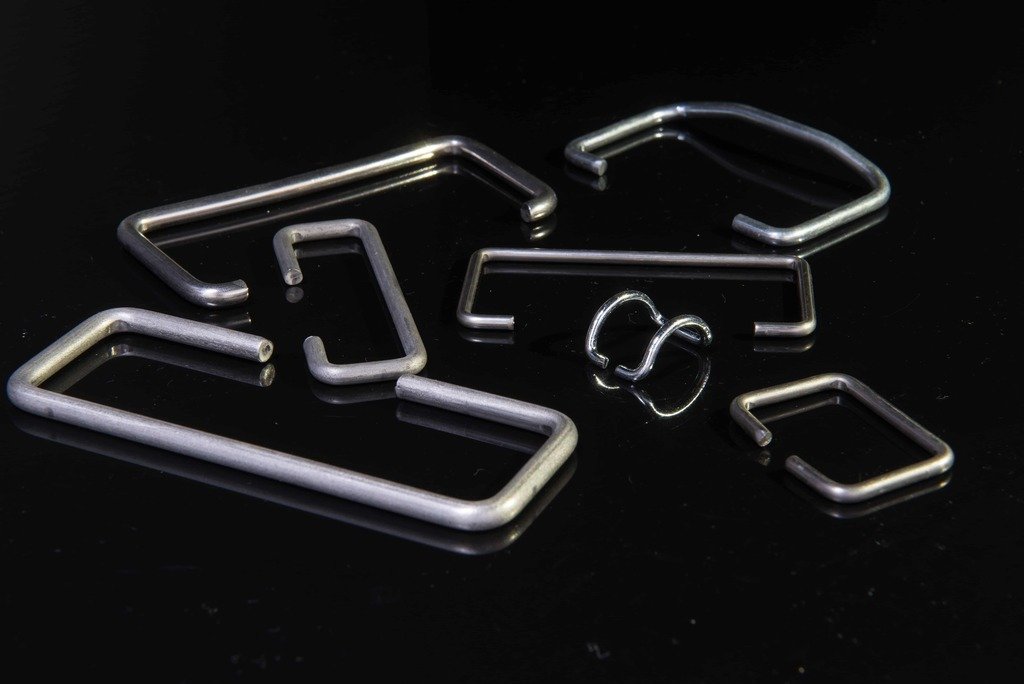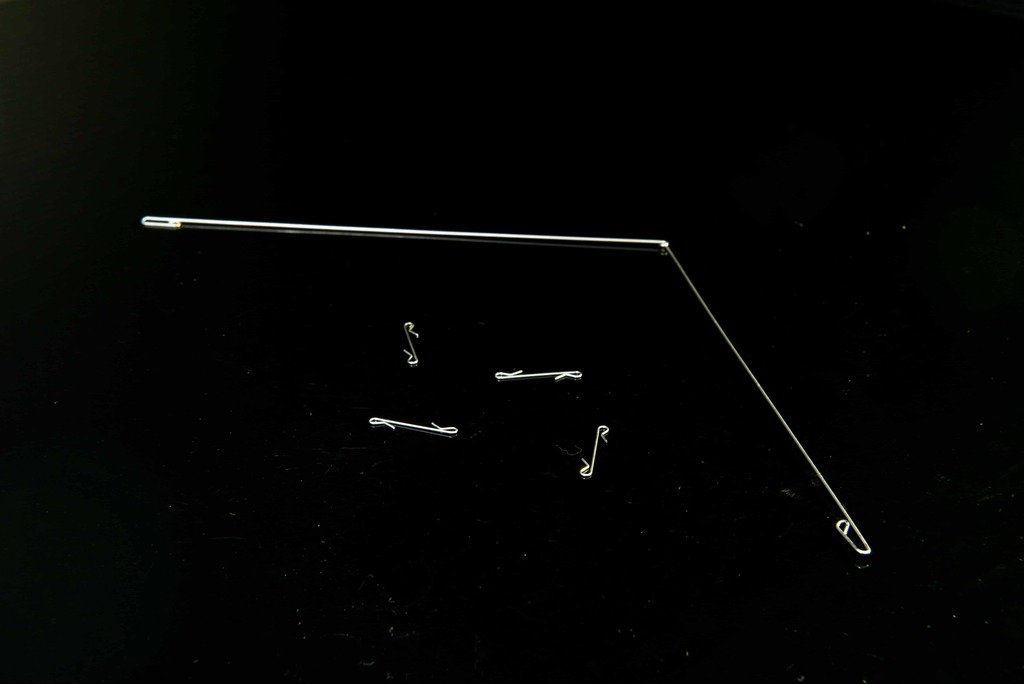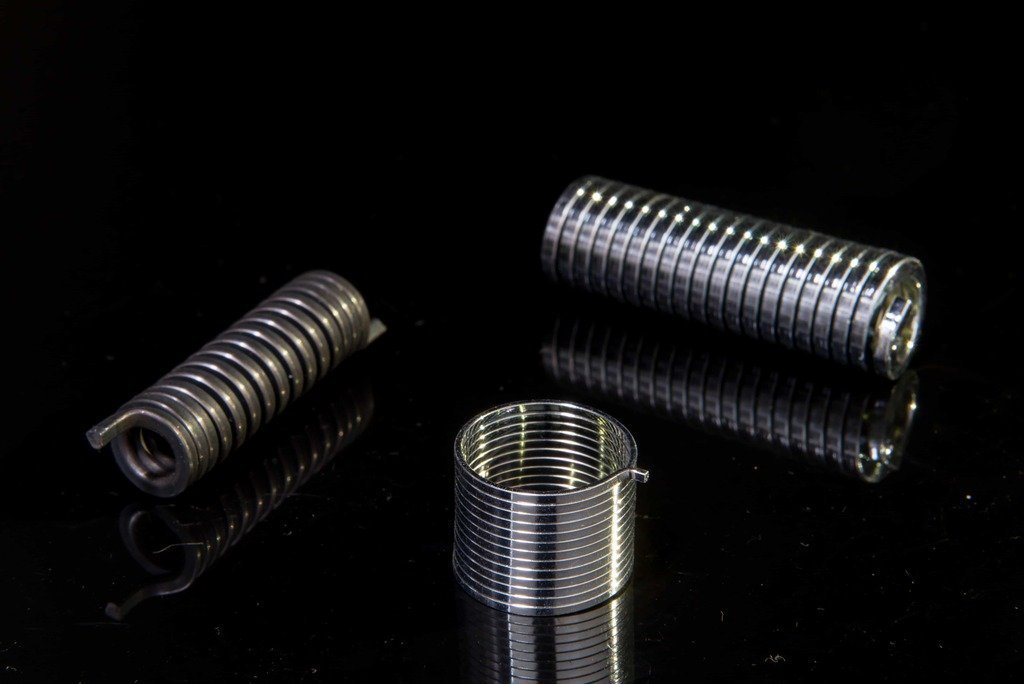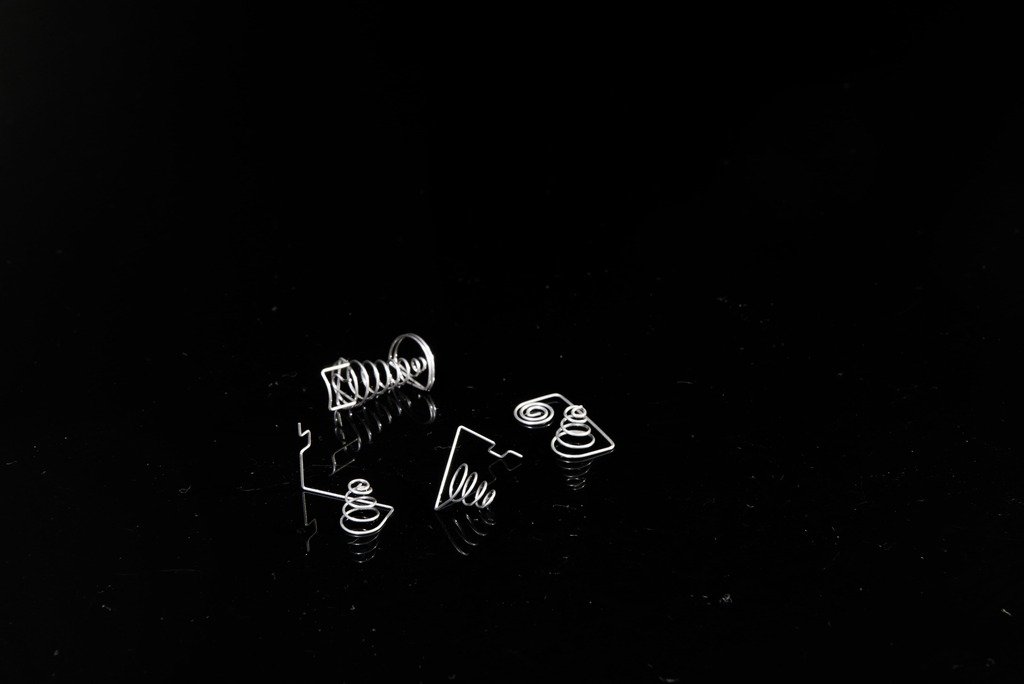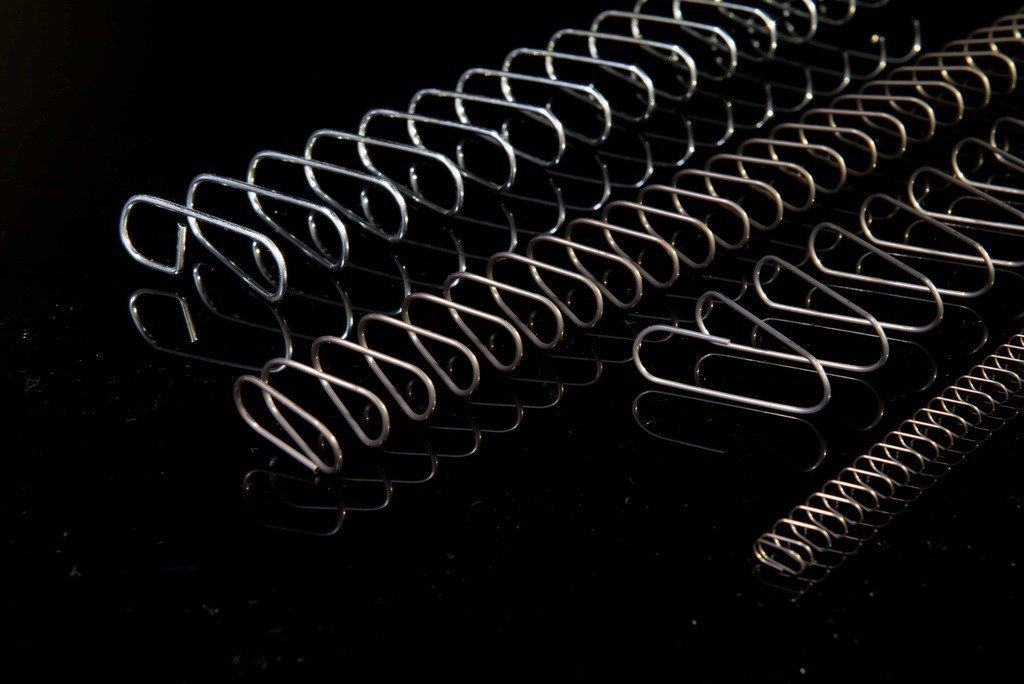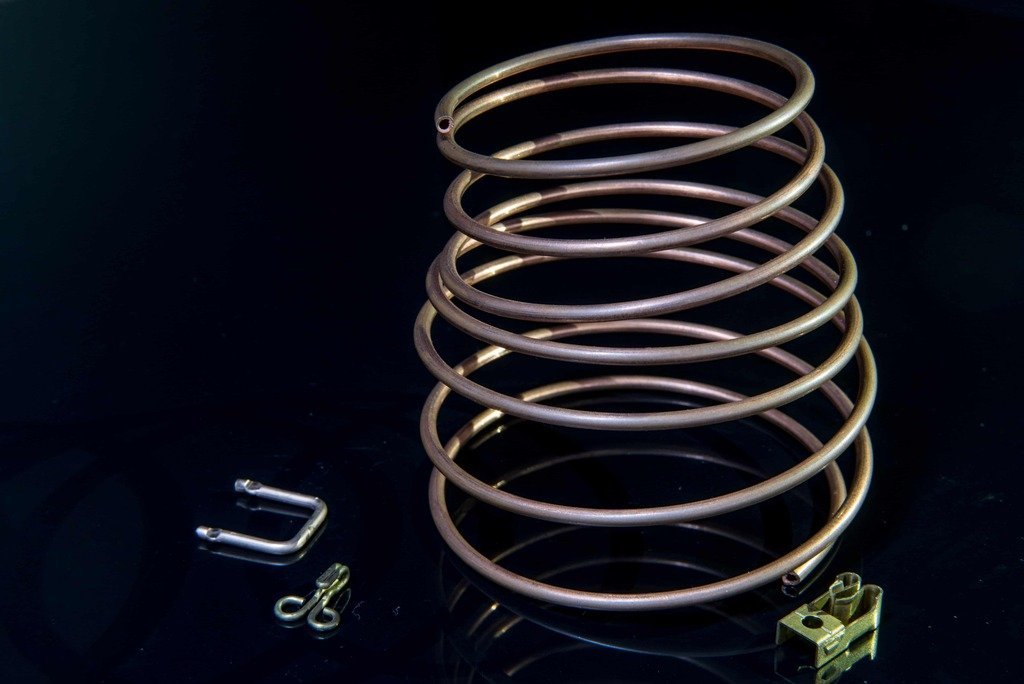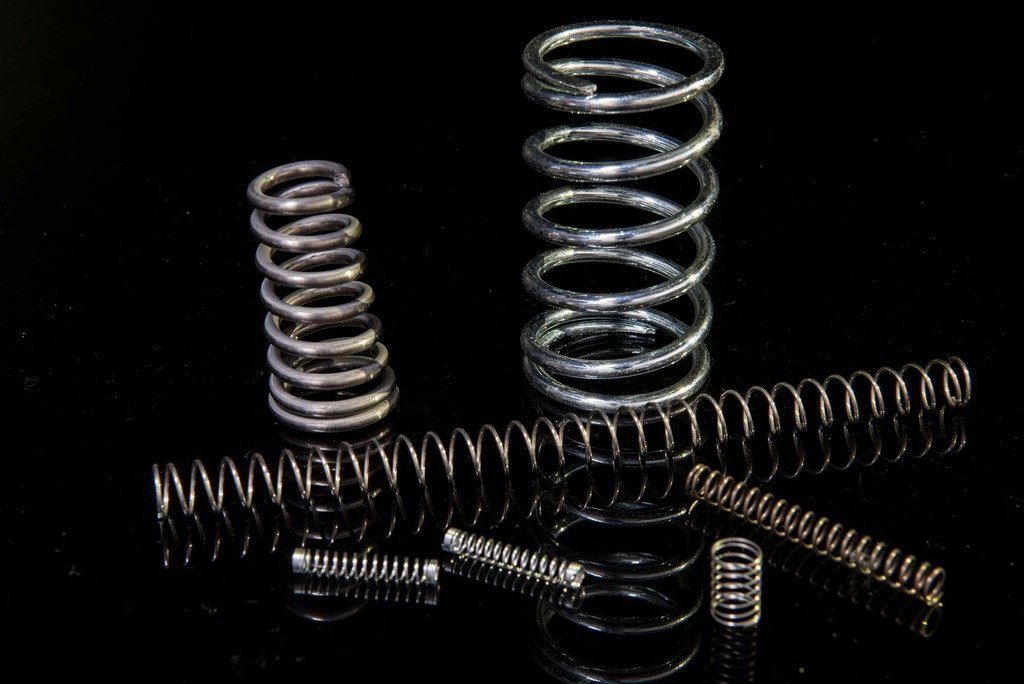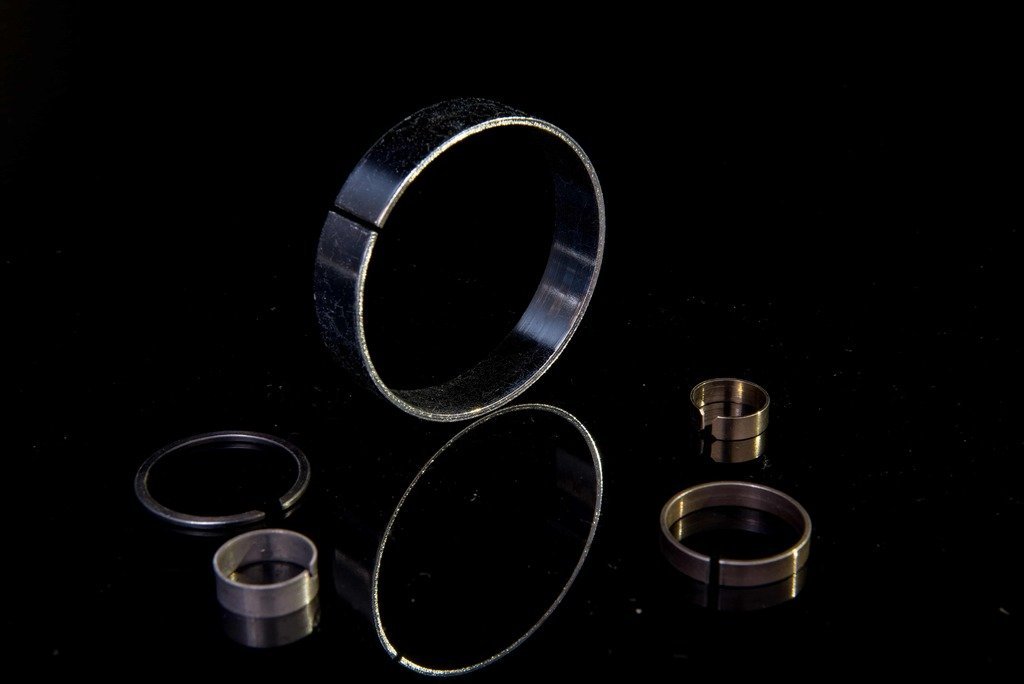Spring design formula and calculations
Here are some gadgets to help you to design springs.
| Vickers 維氏硬度 HV | Brinell 勃氏硬度壓痕HB | Rockwell 洛氏硬度(鋼)HRC | Shore 蕭氏硬度HS |
|---|---|---|---|
| HV | HB | HRC | HS |
| 940 | 68 | 97 | |
| 900 | 67 | 95 | |
| 865 | 66 | 92 | |
| 832 | 65 | 91 | |
| 800 | 64 | 88 | |
| 772 | 63 | 87 | |
| 746 | 62 | 85 | |
| 720 | 61 | 83 | |
| 697 | 60 | 81 | |
| 674 | 59 | 81 | |
| 953 | 58 | 78 | |
| 633 | 57 | 76 | |
| 613 | 56 | 75 | |
| 595 | 55 | 74 | |
| 577 | 54 | 72 | |
| 560 | 53 | 71 | |
| 544 | 500 | 52 | 69 |
| 528 | 487 | 51 | 68 |
| 513 | 475 | 50 | 67 |
| 498 | 464 | 49 | 66 |
| 484 | 451 | 48 | 64 |
| 471 | 442 | 47 | 63 |
| 458 | 432 | 46 | 62 |
| 446 | 421 | 45 | 60 |
| 434 | 409 | 44 | 58 |
| 423 | 400 | 43 | 57 |
| 412 | 390 | 42 | 56 |
| 402 | 381 | 41 | 55 |
| 392 | 371 | 40 | 54 |
| 382 | 362 | 39 | 53 |
| 372 | 353 | 38 | 52 |
| 363 | 344 | 37 | 51 |
| 354 | 336 | 36 | 50 |
| 345 | 327 | 35 | 49 |
| 336 | 319 | 34 | 48 |
| 327 | 311 | 33 | 47 |
| 318 | 301 | 32 | 46 |
| 310 | 294 | 31 | 45 |
| 302 | 286 | 30 | 44 |
| 294 | 279 | 29 | 43 |
| 286 | 271 | 28 | 42 |
| 279 | 264 | 27 | 41 |
| 272 | 258 | 26 | 40 |
| 266 | 253 | 25 | 39 |
| 260 | 247 | 24 | 38 |
| 254 | 243 | 23 | 37 |
| 248 | 237 | 22 | 36 |
| 243 | 231 | 21 | 35 |
| 238 | 226 | 20 | 34 |
| 230 | 219 | 18 | 33 |
| 222 | 212 | 16 | 32 |
| 213 | 203 | 14 | 31 |
| Type of wire | |||||
|---|---|---|---|---|---|
| Code | Name | Characteristics | G(kgf/mm2) | Specific gravity (g/cm3) | Feature Description |
| SWRM | Low carbon steel wire SAE1008 | Widely used | 8000 | 7.85 | The strength is low, but the toughness is good, the weldability is good, and the cold stamping property is excellent. It is often used to manufacture products such as chains, rivets, bolts, and shafts. |
| SW-A | SWC | Widely used | 8000 | 7.85 | Hard steel wires are classified and named according to their carbon content, diameter, mechanical properties and use. JIS G 3521 divided into three types: SW-A, SW-B and SW-C. According to the carbon content of the wire, the hardness is determined. The minimum carbon content is 40C and the maximum is 80C. |
| SW-B | Hard steel wire Type B | Widely used | 8000 | 7.85 | |
| SW-C | Hard steel wire Type C | Widely used | 8000 | 7.85 | |
| SWPA | Piano wire Type A | Widely used, Corrosion resistant | 8000 | 7.85 | General use, high durability, piano steel wire can be used for engine valve springs, mechanical springs and musical instruments. |
| SWOA | Oil tempering line Type A | Widely used | 8000 | 7.85 | Oil tempered carbon steel wire for spring SWO (JIS G 3560), Oil tempered carbon steel wire for general valve SWO-V (JIS G 3561), Oil tempered chrome vanadium steel wire for fatigue resistance valve SWOCV-V (JIS G 3565 ) Heat and fatigue resistance 41-55 Spring material that is more durable than piano steel wire. Commonly used in car shock absorbers, engine valve springs. |
| SUSWPA | Stainless steel wire No.1 | Widely used, Heat resistant, Corrosion resistant | 7000 | 8.02 | 304 is a general-purpose stainless steel that is widely used to make equipment and parts that require good overall properties (corrosion resistance and formability). 301 stainless steel exhibits obvious work hardening phenomenon during deformation, and is used in various occasions requiring higher strength. 302 stainless steel is essentially a variant of 304 stainless steel with higher carbon content, which can obtain higher strength by cold rolling. 316 stainless steel contains aluminum, so its resistance to pitting corrosion in marine and chemical industry environments is much better than 304 stainless steel. |
| BeCuW | Beryllium copper wire | Conductive, Non-magnetic, Corrosion resistant | 4500 | 8.6 | Also known as copper beryllium, beryllium bronze or spring copper, it refers to a copper alloy with a beryllium content of 0.5 to 3%, sometimes adding other alloying elements. Beryllium copper is a non-magnetic, non-sparking high-strength material with excellent metal processing. It has many applications in harmful environments, musical instruments, precision measuring devices, ammunition and aerospace. |
| PBW | Phosphor‑bronze wire | Conductive, Non-magnetic, Corrosion resistant | 4300 | 8.8 | Phosphor bronze wire is a high strength copper alloy with excellent corrosion resistance, fatigue strength, mechanical properties and electrical conductivity. Uses Springs, guitar strings, high-performance electrical terminals, electronic latches, electroplating hooks, mechanical and hardware parts. |
| BsW | Brass wire | Conductive, Non-magnetic, Corrosion resistant | 4000 | 8.5 | |
| Austenitic Stainless Steel | ||||||||||
|---|---|---|---|---|---|---|---|---|---|---|
| The most commonly seen 304 stainless steel is this type of stainless steel. Its standard composition is 18% chromium and 8% nickel, which is generally called 18-8 stainless steel. The characteristics of this type of stainless steel are non-magnetic, its metallographic structure cannot be changed by heat treatment, and its workability is good. Because it contains an alloying element-nickel, its corrosion resistance is better than that of chromium-only (nickel-free). The other two types of stainless steel. The main uses of 300 series stainless steel are: general civilian use such as kitchen tableware, building materials, medical and health equipment, food processing materials, transportation, chemical equipment and pipe fittings, mechanical equipment and parts. For ordinary people, the so-called stainless steel refers to 300 series stainless steel (especially 304 stainless steel). | ||||||||||
| Name | Hardness Number | Characteristic | ||||||||
| Hardness (HV) | Tensile strength (N/mm2) | Yield strength (N/mm2) | Elongation (%) | |||||||
| SUS 301 | 1/2H | 310~370 | ≧ 930 | ≧ 510 | ≧ 10 | |||||
| 3/4H | 370~430 | ≧ 1130 | ≧ 745 | ≧ 5 | ||||||
| H | 430~490 | ≧ 1320 | ≧ 1030 | ─ | ||||||
| EH | 490~530 | ≧ 1570 | ≧ 1275 | ─ | ||||||
| SEH | ≧ 530 | ≧ 1740 | ≧ 1450 | ─ | ||||||
| SUS 304 | O | ≦ 200 | ≧ 520 | ≧ 205 | ≧ 40 | |||||
| 1/2H | 250~310 | ≧ 780 | ≧ 470 | ≧ 6 | ||||||
| 3/4H | 310~370 | ≧ 930 | ≧ 665 | ≧ 3 | ||||||
| H | ≧ 370 | ≧ 1130 | ≧ 880 | ─ | ||||||
| SUS 305 | O | ≦ 200 | ≧ 480 | ≧ 175 | ≧ 40 | |||||
| SUS 310S | O | ≦ 200 | ≧ 520 | ≧ 205 | ≧ 40 | |||||
| SUS 316L | O | ≦ 200 | ≧ 480 | ≧ 175 | ≧ 40 | |||||
| Martensitic Stainless Steel | ||||||||||
| The chemical composition of this type of stainless steel contains 13% chromium, less than 0.15% carbon and a small amount of other element alloys. The raw material is cheap, magnetic, hardened by heat treatment, and increased in strength. However, because it does not contain nickel, its corrosion resistance is inferior to that of ordinary 304 stainless steel, so it can only be used in mildly corrosive environments. General uses include bearings, medical appliances and tools. | ||||||||||
| Name | Hardness Number | Characteristic | ||||||||
| Hardness (HV) | Tensile strength (N/mm2) | Yield strength (N/mm2) | Elongation (%) | |||||||
| SUS 420J2 | O | ≦ 247 | ≧ 540 | ≧ 225 | ≧ 18 | |||||
| SUS 440A | O | ≦ 200 | ≧ 450 | ≧ 205 | ≧ 22 | |||||
| Ferritic Stainless Steel | ||||||||||
| The representative grade of this type of stainless steel is 430, its standard chemical composition is 16~18% chromium, and its carbon content is low. This type of stainless steel is magnetic, and if the stainless steel sheet we see can be attracted by a magnet, it is likely to belong to this type of stainless steel. It is less expensive because it does not contain nickel. Typical uses are kitchen utensils, netting and accessories. | ||||||||||
| Name | Hardness Number | Characteristic | ||||||||
| Hardness (HV) | Tensile strength (N/mm2) | Yield strength (N/mm2) | Elongation (%) | |||||||
| SUS 410L | O | ≦ 200 | ≧ 360 | ≧ 195 | ≧ 22 | |||||
| SUS 430 | O | ≦ 269 | ≧ 590 | ≧ 245 | ≧ 15 | |||||
| Precipitation Hardening Stainless Steel | ||||||||||
| The American Iron and Steel Institute AISI number is 600 series stainless steel. In addition to chromium and nickel, this type of stainless steel also contains precipitation hardening elements such as copper, aluminum and titanium, which harden the material and increase its strength. Typical uses of this type of stainless steel are: valves, motor shafts, petrochemical equipment and golf heads. | ||||||||||
| Name | Heat Treatment Number | Characteristic | ||||||||
| Hardness (HV) | Tensile strength (N/mm2) | Yield strength (N/mm2) | Elongation (%) | |||||||
| SUS 630 | S | About ≦375 | ─ | ─ | ─ | |||||
| H900 | About ≦396 | ≧ 1310 | ≧ 1175 | ≧ 5 | ||||||
| H1025 | About ≦349 | ≧ 1070 | ≧ 1000 | ≧ 5 | ||||||
| H1075 | About ≦319 | ≧ 1000 | ≧ 860 | ≧ 5 | ||||||
| H1150 | About ≦292 | ≧ 930 | ≧ 725 | ≧ 8 | ||||||
| Halogenate | A phosphate film is attached to the metal surface to enhance the adsorption of oil, which can make the anti-rust ability and electrical insulation better. | |||
| Rustproofing | Rustproofing can make the combination of spring and zinc better. Better rust resistance than Electrogalvanizating. | |||
| Nickel Electroplating | Electroplated nickel can prevent rust and be beautiful. Commonly used on battery springs. | |||
| Tin Electroplating | Tin plating is a coating with good solderability and certain corrosion resistance. | |||
| Electrogalvanization | Effective anti-rust ability after electroplating. It is not easy to be corroded in acid and alkali. Ductile after electroplating. Can also be bent. Can be electroplated in various colors | |||
| Chromium Eectroplating | Usually to increase surface hardness and friction resistance. Because chrome is not easy to change color, it is necessary to use the spring in the appearance part. Rust resistance is not as good as galvanized. Expensive. | |||
| Gold Electroplating | In order to have good electrical conductivity.Expensive. | |||
| E-Coating | It can make the appearance similar to baking paint, the color is uniform and the rust resistance is good, and it is suitable for use on products that require appearance. | |||
| Surface Passivation | Applied to stainless steel wire, the stainless steel surface is attached with a film to increase corrosion resistance and rust resistance. | |||
| Powder Coating | Various colors can be adjusted, The surface of the spring can be painted with a layer of 50-300μm. | |||
| Shot Peening | Spray spring products with small beads to eliminate stress and increase the service life of springs, often used on compression springs. | |||
| Grind | Use a grinder to grind the plane at both ends of the compression spring, and the spring can be evenly stressed without tilting when the spring is stressed. | |||
| Black Oxide | Black with oil on the surface. Can prevent rust. But the effect is limited. To achieve the best results, it is recommended to add anti-rust oil to achieve the best results. Cheap. | |||
Refer To Our Products
What can we do for you? Please check our products.
Welcome to inquire us.
- Compression Springs, valve springs, cushion springs. ISO 10243, DIN 2098, JIS B 5012, GB /T 2089, GB /T 2087, GB 4142, GB /T 36524witec2020-11-09T00:46:25+08:00
Contact
Please fill in the following information and we will reply as soon as possible

